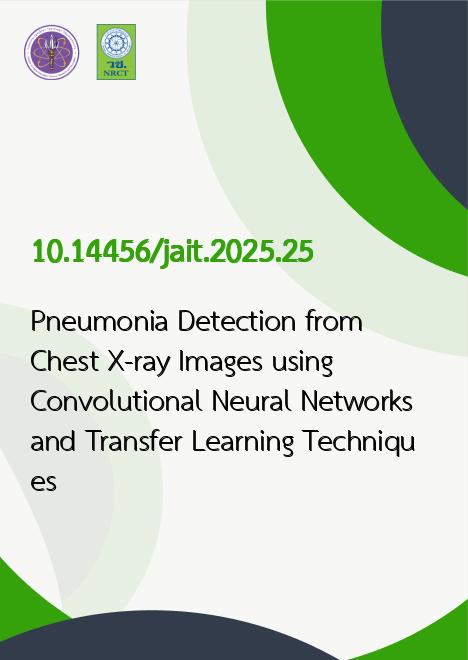
|
Pneumonia Detection from Chest X-ray Images using Convolutional Neural Networks and Transfer Learning Techniques |
|---|---|
| รหัสดีโอไอ | |
| Creator | Pongsathorn Chedsom |
| Title | Pneumonia Detection from Chest X-ray Images using Convolutional Neural Networks and Transfer Learning Techniques |
| Publisher | Faculty of Informatics, Mahasarakham University |
| Publication Year | 2568 |
| Journal Title | Journal of Applied Informatics and Technology |
| Journal Vol. | 7 |
| Journal No. | 2 |
| Page no. | 406-431 |
| Keyword | Pneumonia, Chest X-ray, Convolutional Neural Networks, Transfer Learning, Data Augmentation |
| URL Website | https://ph01.tci-thaijo.org/index.php/jait |
| Website title | Journal of Applied Informatics and Technology |
| ISSN | 3088-1803 |
| Abstract | According to data from the Bureau of Epidemiology, between January 1 and October 31, 2023, a total of 239,197 cases of pneumonia or lung inflammation were reported. Over the past five years (2018–2022), the average number of cases was approximately 20,000 per month, with a continuously increasing trend. Early detection and treatment of pneumonia can significantly reduce mortality rates. This study proposes a classification model for pneumonia based on chest X-ray images using Convolutional Neural Networks (CNNs), specifically the VGG16 and VGG19 architectures, in conjunction with the transfer learning technique. The Chest X-Ray Images (Pneumonia) dataset, consisting of 5,232 images (4,273 pneumonia cases and 1,583 normal cases), was used. Data augmentation techniques were applied, and the dataset was divided into 70% training, 20% validation, and 10% testing sets. The experiments were divided into two groups: Group 1 employed the VGG16 and VGG19 architectures, while Group 2 utilized these architectures with transfer learning and customized Fully Connected (FC) layers. In Group 1, the VGG16 achieved an accuracy of 95.42% with a loss value of 0.18, while VGG19 achieved an accuracy of 94.89% with a loss of 0.21. In Group 2, the best performance was achieved using the VGG16 architecture with customized fully connected (FC) layers, consisting of nine layers with 2048, 1024, 512, 256, 128, 64, 32, 16, and 8 nodes, respectively. This configuration achieved the highest accuracy of 97.83% and the lowest loss of 0.11. Compared to the VGG16, the model achieved a 2.41% improvement in accuracy and a 0.07 reduction in loss. When compared to the unmodified VGG19, accuracy improved by 2.94% and loss decreased by 0.10. |